Abstract
1 The relationship between mechanical fragility, glutathione peroxidase inhibition and Heinz body formation, in erythrocytes exposed to oxidant drugs in vitro, has been investigated. All drugs tested caused Heinz body formation, and with the exception of acetyl salicylic acid and salicylic acid, also caused increased erythrocyte mechanical fragility.
2 There was a direct relationship between mechanical fragility and drug concentration. Mechanical fragility increased in parallel with Heinz body formation, with primaquine, gentisic acid, ascorbic acid and potassium chlorate. In contrast Heinz body formation occurred at drug concentrations which did not cause a marked increase in mechanical fragility in the case of menadione, acetyl phenylhydrazine and phenylhydrazine.
3 The degree of inhibition of glutathione peroxidase was directly related to increased mechanical fragility with menadione, gentisic acid and potassium chlorate. However other substances causing increased mechanical fragility resulted in little or no loss of glutathione peroxidase activity.
4 The results show that there is no constant relationship between mechanical fragility caused by drugs, the formation of Heinz bodies and the inhibition of glutathione peroxidase. The factors contributing to oxidant drug-induced haemolysis appear to be variable and depend upon the drug concerned.
Full text
PDF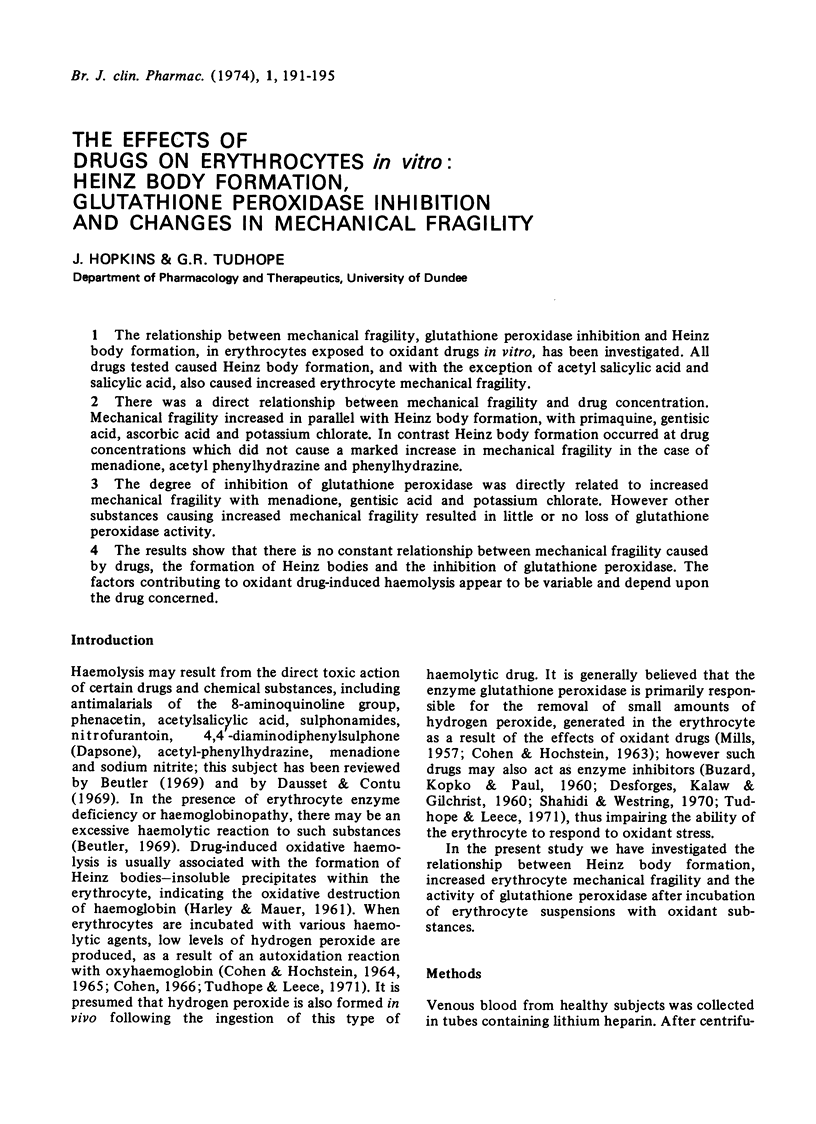
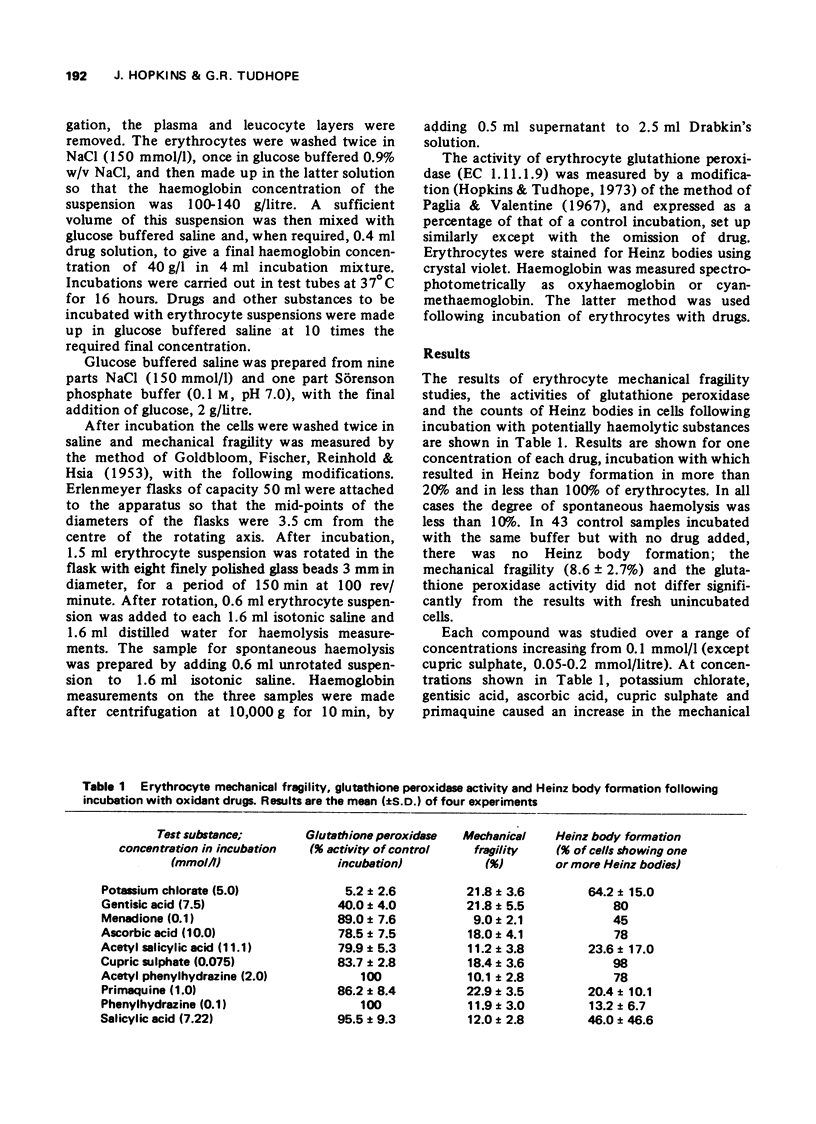
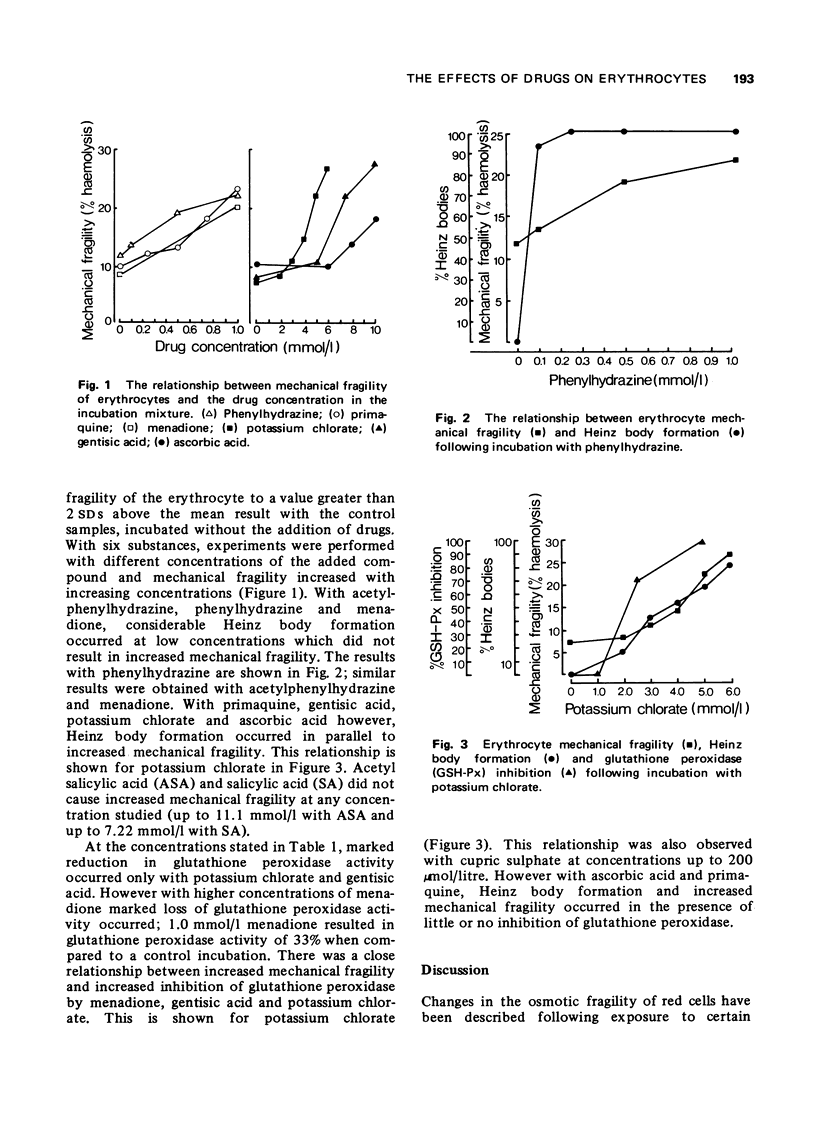
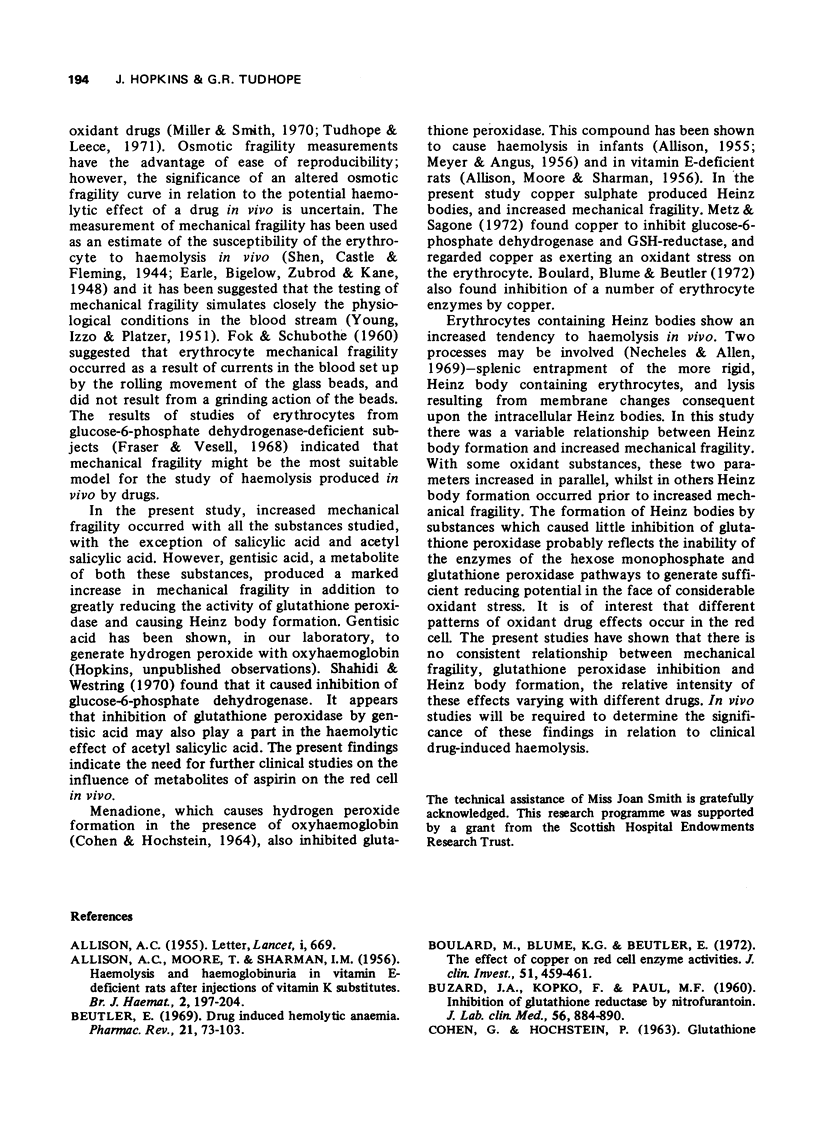
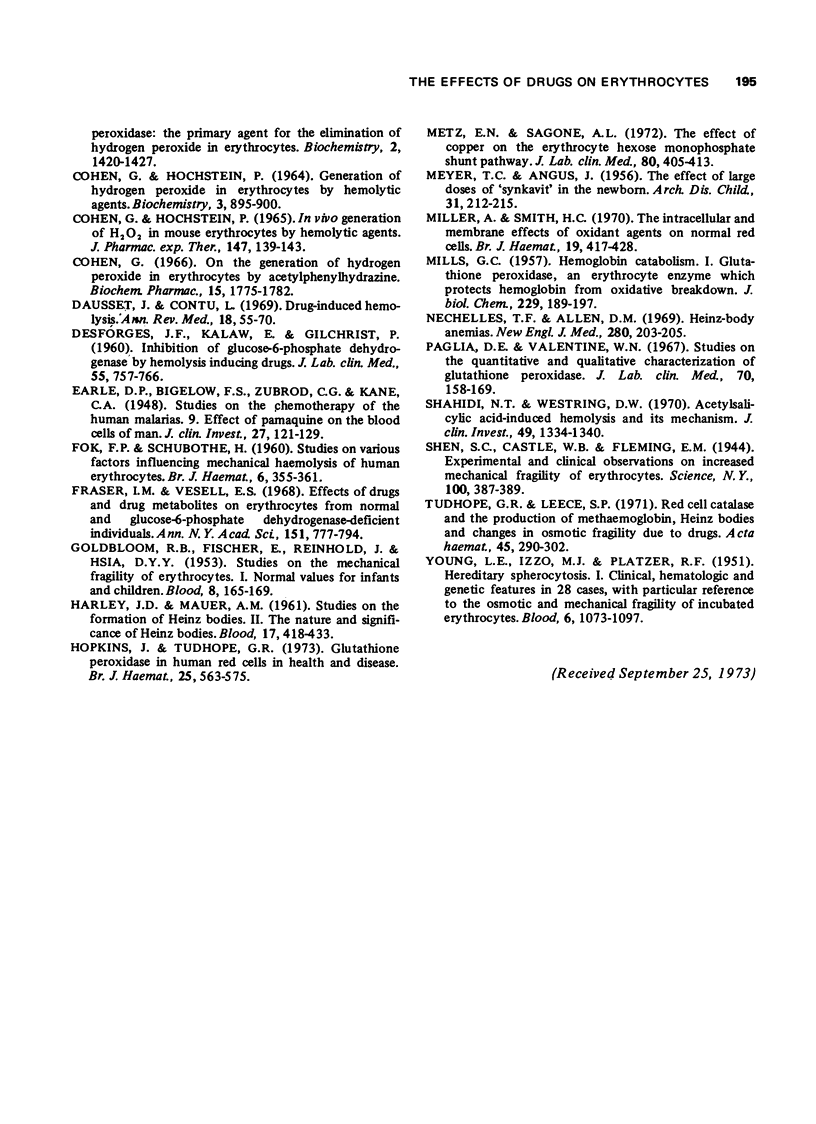
Selected References
These references are in PubMed. This may not be the complete list of references from this article.
- ALLISON A. C., MOORE T., SHARMAN I. M. Haemolysis and haemoglobinuria in vitamin-E deficient rats after injections of vitamin-K substitutes. Br J Haematol. 1956 Apr;2(2):197–204. doi: 10.1111/j.1365-2141.1956.tb06828.x. [DOI] [PubMed] [Google Scholar]
- BUZARD J. A., KOPKO F., PAUL M. F. Inhibition of glutathione reductase by nitrofurantoin. J Lab Clin Med. 1960 Dec;56:884–890. [PubMed] [Google Scholar]
- Beutler E. Drug-induced hemolytic anemia. Pharmacol Rev. 1969 Mar;21(1):73–103. [PubMed] [Google Scholar]
- Boulard M., Blume K. G., Beutler E. The effect of copper on red cell enzyme activities. J Clin Invest. 1972 Feb;51(2):459–461. doi: 10.1172/JCI106833. [DOI] [PMC free article] [PubMed] [Google Scholar]
- COHEN G., HOCHSTEIN P. GENERATION OF HYDROGEN PEROXIDE IN ERYTHROCYTES BY HEMOLYTIC AGENTS. Biochemistry. 1964 Jul;3:895–900. doi: 10.1021/bi00895a006. [DOI] [PubMed] [Google Scholar]
- COHEN G., HOCHSTEIN P. GLUTATHIONE PEROXIDASE: THE PRIMARY AGENT FOR THE ELIMINATION OF HYDROGEN PEROXIDE IN ERYTHROCYTES. Biochemistry. 1963 Nov-Dec;2:1420–1428. doi: 10.1021/bi00906a038. [DOI] [PubMed] [Google Scholar]
- COHEN G., HOCHSTEIN P. IN VIVO GENERATION OF H2O2 IN MOUSE ERYTHROCYTES BY HEMOLYTIC AGENTS. J Pharmacol Exp Ther. 1965 Jan;147:139–143. [PubMed] [Google Scholar]
- DESFORGES J. F., KALAW E., GILCHRIST P. Inhibition of glucose-6-phosphate dehydrogenase by hemolysis inducing drugs. J Lab Clin Med. 1960 May;55:757–766. [PubMed] [Google Scholar]
- Dausset J., Contu L. Drug-induced hemolysis. Annu Rev Med. 1967;18:55–70. doi: 10.1146/annurev.me.18.020167.000415. [DOI] [PubMed] [Google Scholar]
- Earle D. P., Bigelow F. S., Zubrod C. G., Kane C. A. STUDIES ON THE CHEMOTHERAPY OF THE HUMAN MALARIAS. IX. EFFECT OF PAMAQUINE ON THE BLOOD CELLS OF MAN. J Clin Invest. 1948 May;27(3 Pt 2):121–129. doi: 10.1172/JCI101950. [DOI] [PMC free article] [PubMed] [Google Scholar]
- FOK F. P., SCHUBOTHE H. Studies on various factors influencing mechanical haemolysis of human erythrocytes. Br J Haematol. 1960 Oct;6:355–361. doi: 10.1111/j.1365-2141.1960.tb06253.x. [DOI] [PubMed] [Google Scholar]
- Fraser I. M., Vesell E. S. Effects of drugs and drug metabolites on erythrocytes from normal and glucose-6-phosphate dehydrogenase-deficient individuals. Ann N Y Acad Sci. 1968 Jul 31;151(2):777–794. doi: 10.1111/j.1749-6632.1968.tb48261.x. [DOI] [PubMed] [Google Scholar]
- GOLDBLOOM R. B., FISCHER E., REINHOLD J., HSIA D. Y. Y. Studies on the mechanical fragility of erythrocytes. I. Normal values for infants and children. Blood. 1953 Feb;8(2):165–169. [PubMed] [Google Scholar]
- HARLEY J. D., MAUER A. M. Studies on the formation of Heinz bodies. II. The nature and significance of Heinz bodies. Blood. 1961 Apr;17:418–433. [PubMed] [Google Scholar]
- Hopkins J., Tudhope G. R. Glutathione peroxidase in human red cells in health and disease. Br J Haematol. 1973 Nov;25(5):563–575. doi: 10.1111/j.1365-2141.1973.tb01768.x. [DOI] [PubMed] [Google Scholar]
- MEYER T. C., ANGUS J. The effect of large doses of synkavit in the newborn. Arch Dis Child. 1956 Jun;31(157):212–215. doi: 10.1136/adc.31.157.212. [DOI] [PMC free article] [PubMed] [Google Scholar]
- MILLS G. C. Hemoglobin catabolism. I. Glutathione peroxidase, an erythrocyte enzyme which protects hemoglobin from oxidative breakdown. J Biol Chem. 1957 Nov;229(1):189–197. [PubMed] [Google Scholar]
- Metz E. N., Sagone A. L., Jr The effect of copper on the erythrocyte hexose monophosphate shunt pathway. J Lab Clin Med. 1972 Sep;80(3):405–413. [PubMed] [Google Scholar]
- Miller A., Smith H. C. The intracellular and membrane effects of oxidant agents on normal red cells. Br J Haematol. 1970 Sep;19(3):417–428. doi: 10.1111/j.1365-2141.1970.tb01638.x. [DOI] [PubMed] [Google Scholar]
- Necheles T. F., Allen D. M. Current concepts: Heinz-body anemias. N Engl J Med. 1969 Jan 23;280(4):203–206. doi: 10.1056/NEJM196901232800406. [DOI] [PubMed] [Google Scholar]
- Paglia D. E., Valentine W. N. Studies on the quantitative and qualitative characterization of erythrocyte glutathione peroxidase. J Lab Clin Med. 1967 Jul;70(1):158–169. [PubMed] [Google Scholar]
- Shahidi N. T., Westring D. W. Acetylsalicylic acid--induced hemolysis and its mechanism. J Clin Invest. 1970 Jul;49(7):1334–1340. doi: 10.1172/JCI106349. [DOI] [PMC free article] [PubMed] [Google Scholar]
- Shen S. C., Castle W. B., Fleming E. M. EXPERIMENTAL AND CLINICAL OBSERVATIONS ON INCREASED MECHANICAL FRAGILITY OF ERYTHROCYTES. Science. 1944 Oct 27;100(2600):387–389. doi: 10.1126/science.100.2600.387. [DOI] [PubMed] [Google Scholar]
- Tudhope G. R., Leece S. P. Red-cell catalase and the production of methaemoglobin, Heinz bodies and changes in osmotic fragility due to drugs. Acta Haematol. 1971;45(5):290–302. doi: 10.1159/000208639. [DOI] [PubMed] [Google Scholar]
- YOUNG L. E., IZZO M. J., PLATZER R. F. Hereditary spherocytosis. I. Clinical, hematologic and genetic features in 28 cases, with particular reference to the osmotic and mechanical fragility of incubated erythrocytes. Blood. 1951 Nov;6(11):1073–1098. [PubMed] [Google Scholar]


